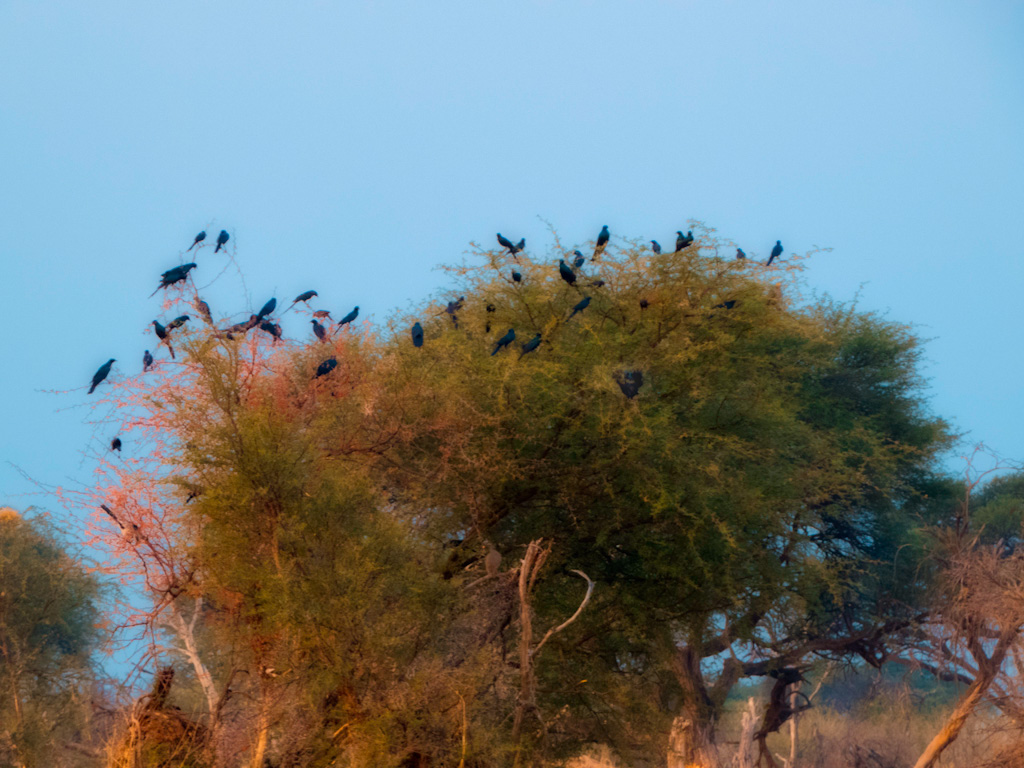
Last fall I had the good fortune to go on a safari in Botswana (it was spring there below the equator) where I saw some beautiful birds. While Botswana does not have any endemic species of birds, it is nonetheless one of Africa’s top birding areas because of its protection of a number of threatened and endangered species. The best season in Botswana for number of species is during the summer months, when the migrants have arrived, but this is not to say that the winter months are a bad birding time. On the contrary, it is easier to find birds during the dry winter months when their movements are restricted to permanent water sources and pools drying to mud with trapped fish and crustaceans. I have arbitrarily separated the smaller and larger birds into separate posts. As a disclaimer, since the stated purpose of the safari was large mammals, it was challenging to get adequate closeup photos of the smaller birds, I have presented what I have.
Rollers
The rollers are an Old World family, Coraciidae, of near passerine birds. The group gets its name from the aerial acrobatics some of these birds perform during courtship or territorial flights. Rollers resemble crows in size and build, and share the colorful appearance of kingfishers and bee-eaters, blues and pinkish or cinnamon browns predominating. The two inner front toes are connected, but not the outer one.
Lilac Breasted Roller
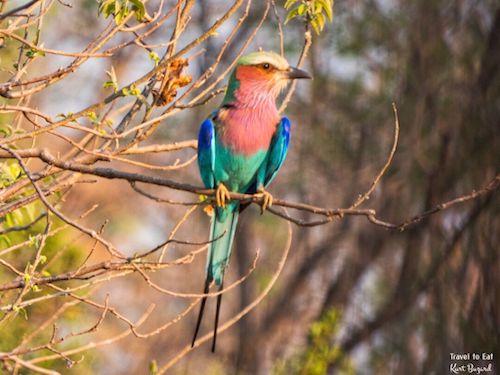
The Lilac-Breasted Roller (Coracias caudatus) is an African member of the roller family of birds, reaching a length of 11.5 in (29 cm) or 14.5 in (37 cm) including streamers, weighing 3.2-4.8 oz (90–135 g). It is widely distributed in sub-Saharan Africa and the southern Arabian Peninsula, preferring open woodland and savanna; it is largely absent from treeless places. They are the unofficial bird if Kenya, for good reason. It is widely distributed in sub-Saharan Africa and the southern Arabian Peninsula, preferring open woodland and savanna; it is largely absent from treeless places. Usually found alone or in pairs, it perches conspicuously at the tops of trees, poles or other high vantage points from where it can spot insects, lizards, scorpions, snails, small birds and rodents moving about at ground level. The sexes are alike in coloration. Juveniles do not have the long tail feathers that adults do.
Bee-Eaters
The bee-eaters are a group of near-passerine birds in the family Meropidae containing three genera and 27 species. Most species are found in Africa and Asia, with a few in southern Europe, Australia, and New Guinea. They are characterised by richly colored plumage, slender bodies, and usually elongated central tail feathers. The bee-eaters have been considered to be related to other families, such as the rollers, hoopoe and kingfishers, but ancestors of those families diverged from the bee-eaters at least forty million years ago, so any relationship is not close.
Little Bee-Eater
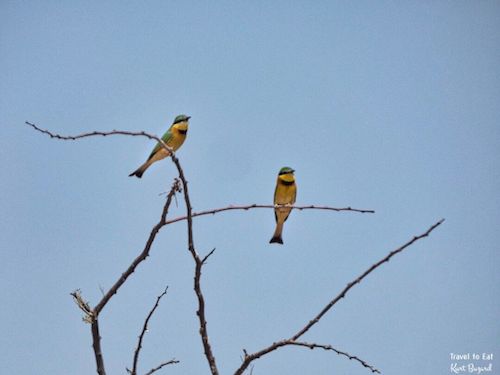
The Little Bee-Eater (Merops pusillus) bird is in the bee-eater family Meropidae. It reaches a length of 6-6.7 in (15–17 cm) long, weighing 0.4-0.6 oz (11–18 g), which makes it the smallest African bee-eater. It is resident in much of Sub-Saharan Africa. It should not be confused with the little green bee-eater, Merops orientalis. Migration is limited to seasonal movements depending on rainfall patterns. This species, like other bee-eaters, is a rich and brightly colored slender bird. It has green upper parts, yellow throat, black gorget, and rich brown upper breast fading to buffish ocre on the belly. The wings are green and brown, and the beak is black. Sexes are alike. Often silent, their call is a soft “seep.”
White Fronted Bee-Eater
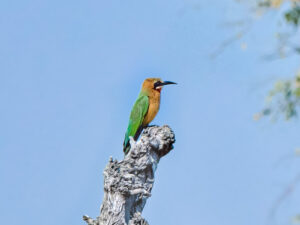
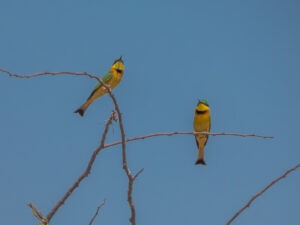
The White-Fronted Bee-Eater (Merops bullockoides) is a species of bee-eater widely distributed in sub-equatorial Africa. It reaches a length of 8.7-9.4 in (22–24 cm) long, weighing 1-1.4 oz (30–40 g). They have a distinctive white forehead, a square tail and a bright red patch on their throat. They nest in small colonies, digging holes in cliffs or earthen banks but can usually be seen in low trees waiting for passing insects from which they hunt either by making quick hawking flights or gliding down before hovering briefly to briefly to catch insects.
Southern Carmine Bee-Eater
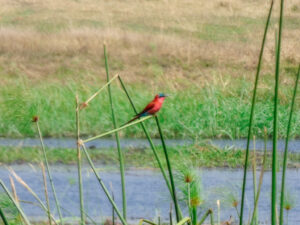
The Southern Carmine Bee-Eater (Merops nubicoides) (formerly carmine bee-eater) occurs across sub-equatorial Africa. It is a large, spectacular, long, slender, carmine-pink and teal-blue bee-eater with a long, pointed tail and black bill and facial mask. It reaches a length of 10 in (26 cm) long, 15 in (38 cm) including streamers, weighing 1.8-2.6 oz (52–75 g). Immature birds are duller than adults and lack long tail feathers. This is a migratory species, spending the breeding season, between August and November, in Zimbabwe, before moving south to South Africa for the summer months, and then migrating to equatorial Africa from March to August. It is a common non-breeding summer migrant (December–April) to Kruger (in South Africa), where it can gather in large groups and often attends bush fires to feed on fleeing insects.
Weavers
The Ploceidae are a family of small passerine birds, many of which are called weavers or weaverbirds. This name comes from the nests of intricately woven vegetation that many birds of the family make. All birds of the Ploceidae are native to the Old World, most in Africa south of the Sahara, though a few live in tropical areas of Asia. A few species have been introduced outside their native range.
Red-Billed Quelea
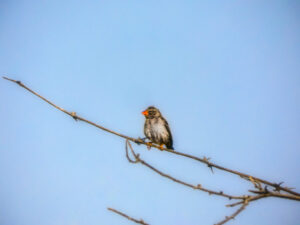
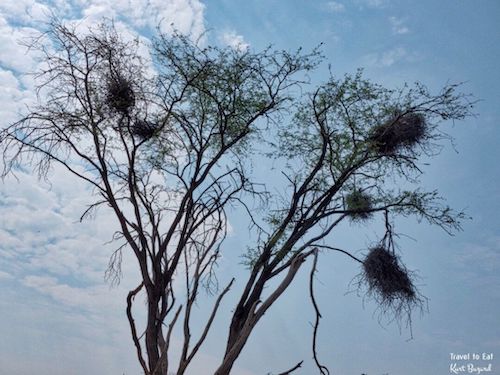
The Red-Billed Quelea (Quelea quelea), also known as the red-billed weaver or red-billed dioch, is a small—approximately 4.7 in (12 cm) long and weighing 0.53–0.92 oz (15–26 g)—migratory, sparrow-like bird of the weaver family, Ploceidae, native to Sub-Saharan Africa. It feeds primarily on seeds of annual grasses, but also causes extensive damage to cereal crops. Therefore, it is sometimes called “Africa’s feathered locust”. It is regarded as the most numerous undomesticated bird on earth, with the total post-breeding population sometimes peaking at an estimated 1½ billion individuals. Outside the breeding season, the male lacks bright colors; it has a grey-brown head with dark streaks, whitish chin and throat, and a faint light stripe above the eyes. At this time, the bill becomes pink or dull red and the legs turn flesh-colored. The females resemble the males in non-breeding plumage, but have a yellow or orangey bill and eye-ring during the breeding season. At other times, the female bill is pink or dull red.
Stonechats
Saxicola, the stonechats or chats, is a genus of 15 species of small passerine birds restricted to the Old World. They are insectivores occurring in open scrubland and grassland with scattered small shrubs. The genus was formerly included in the thrush family Turdidae, but as with several other related genera, has now been shown to be correctly classified in the Old World flycatcher family Muscicapidae.
African Stonechat
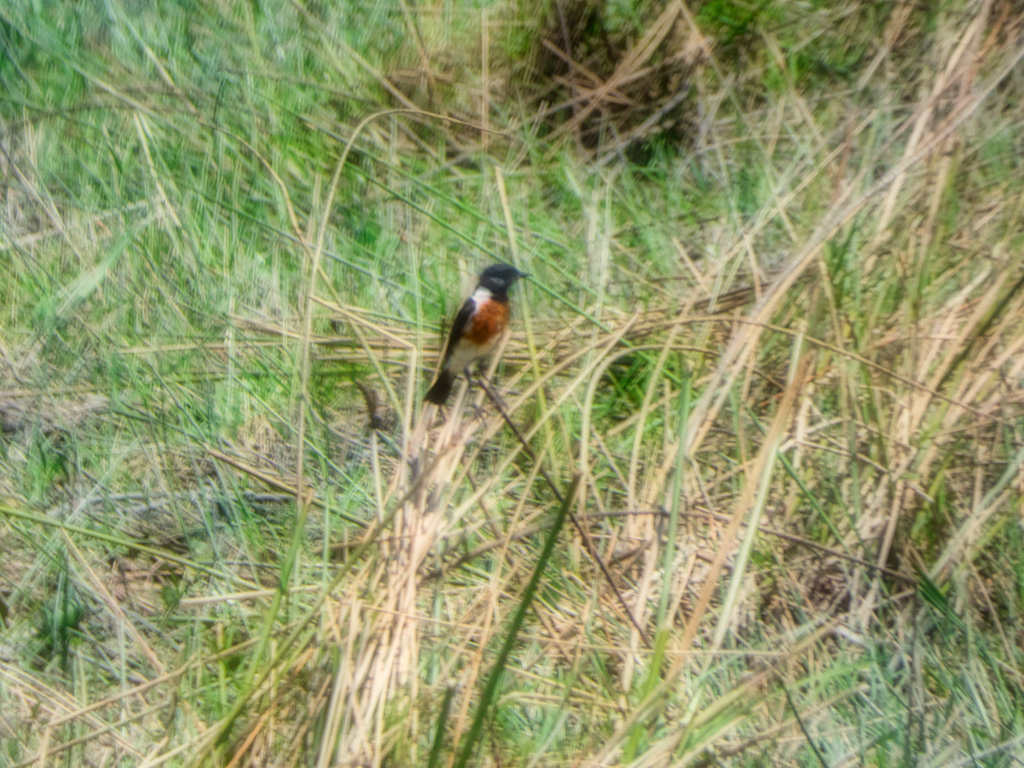
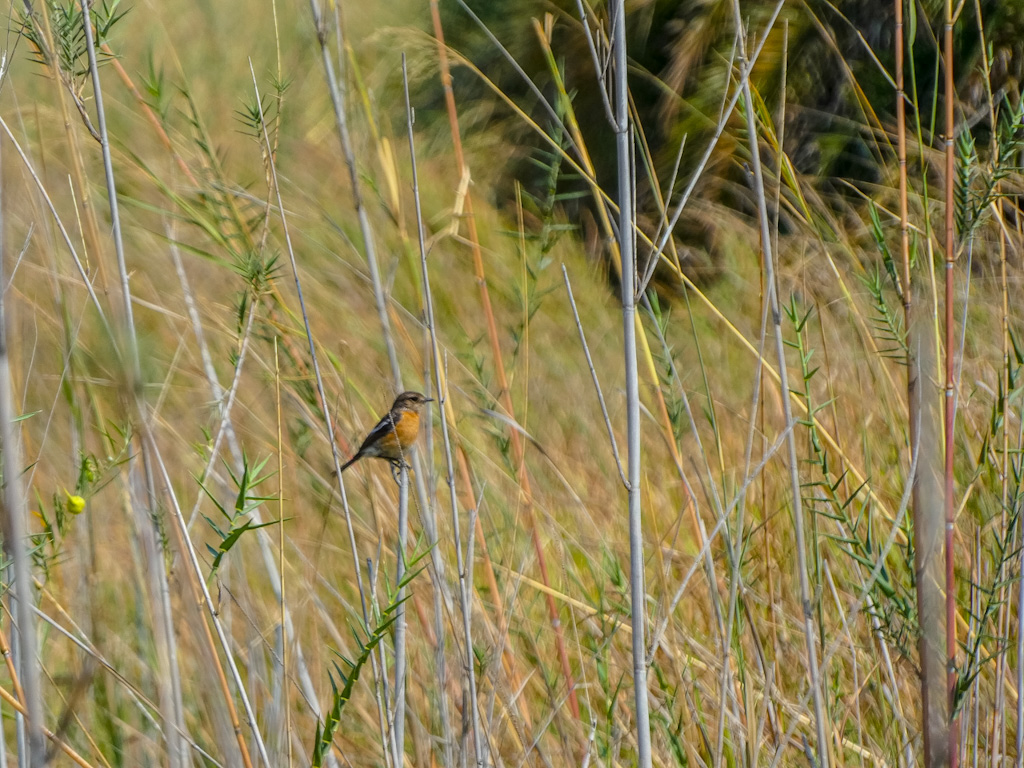
The African Stonechat (Saxicola torquatus) has a scattered distribution across much of sub-Saharan Africa, reaching a length of 5 in (13 cm) with a weight of 0.4-0.6 oz (12–17 g). It is non-migratory, moving only locally if at all. As a result, it has developed much regional variation, being divided into about 15 subspecies. It mainly eats insects and their larvae, supplemented with other invertebrates, lizards, fruit and seeds. It does most of its foraging from a perch, pouncing on prey on the ground and occasionally hawking insects aerially. It may also forage along rocky shores, hawking prey such as fish from perches on rocks and kelp. The subspecies differ slightly in size, and more in the extent of the orange-red on the upper breast of the males, and whether the lower breast is white with a distinct boundary from the upper breast, or pale orange with an indistinct boundary from the darker upper breast.
Kingfishers
The kingfishers family Alcedinidae is in the order Coraciiformes, which also includes the motmots, bee-eaters, todies, rollers and ground-rollers. There are 87 species of kingfishers in the world, ranging in size from the large kookaburras of Australia, weighing nearly half a kilogram, to the miniscule African Dwarf Kingfisher, which weighs only 9–12 grams. Sixteen of the 87 species occur in Africa. All kingfishers have large heads, long, sharp, pointed bills, short legs, and stubby tails. Most species have bright plumage with only small differences between the sexes. Like other members of their order, they nest in cavities, usually tunnels dug into the natural or artificial banks in the ground. Some kingfishers nest in arboreal termite nests.
Giant Kingfisher
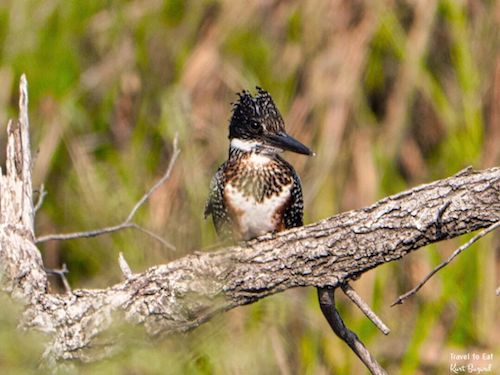
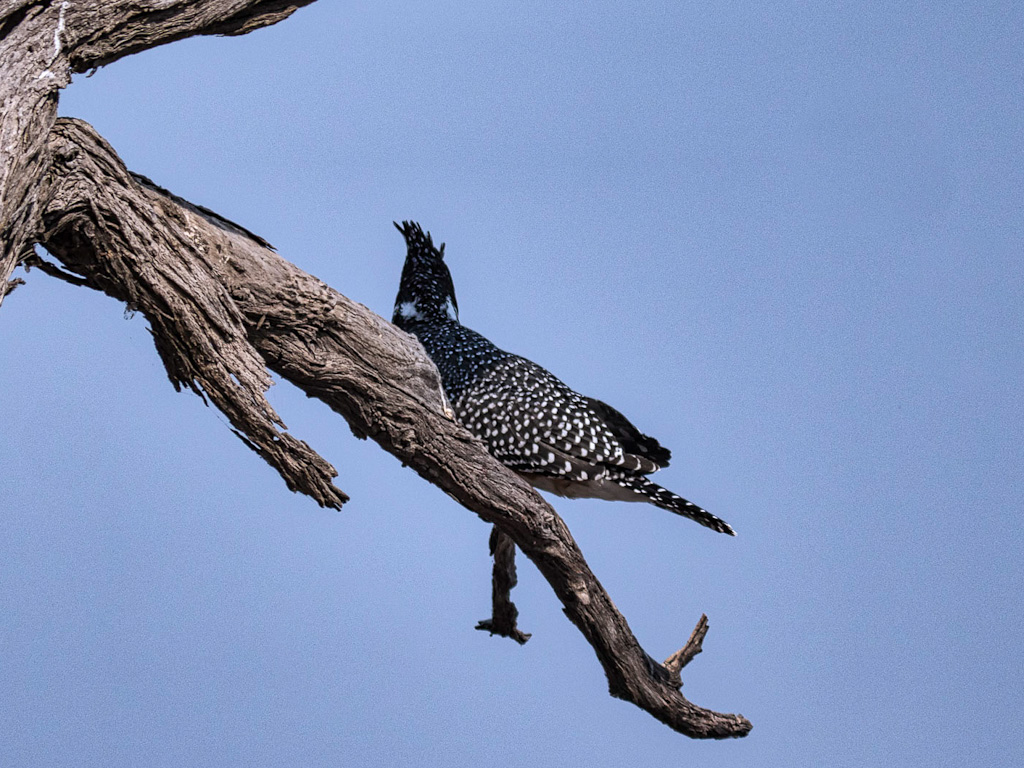
The Giant Kingfisher (Megaceryle maxima) is the largest kingfisher in Africa, where it is a resident breeding bird over most of the continent south of the Sahara Desert other than the arid southwest. The giant kingfisher is 16.5–18 in (42–46 cm) long, with a large shaggy crest, a large black bill and fine white spots on black upperparts. The male has a chestnut breast band and otherwise white underparts with dark flank barring. The female has a white-spotted black breast band and a chestnut belly. The forest race M. m. gigantea is darker, less spotted above, and more barred below than the nominate race, but the two forms intergrade along the forest edge zone. This large species feeds on crabs, fish, and frogs, caught by diving from a perch.
Pied Kingfisher
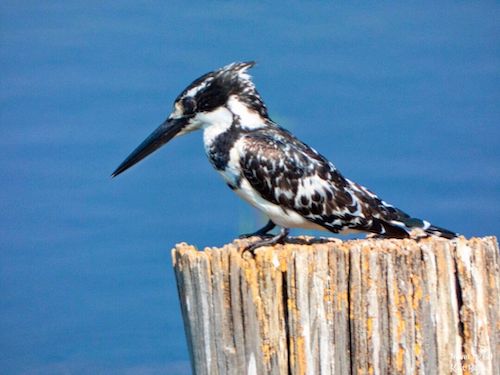
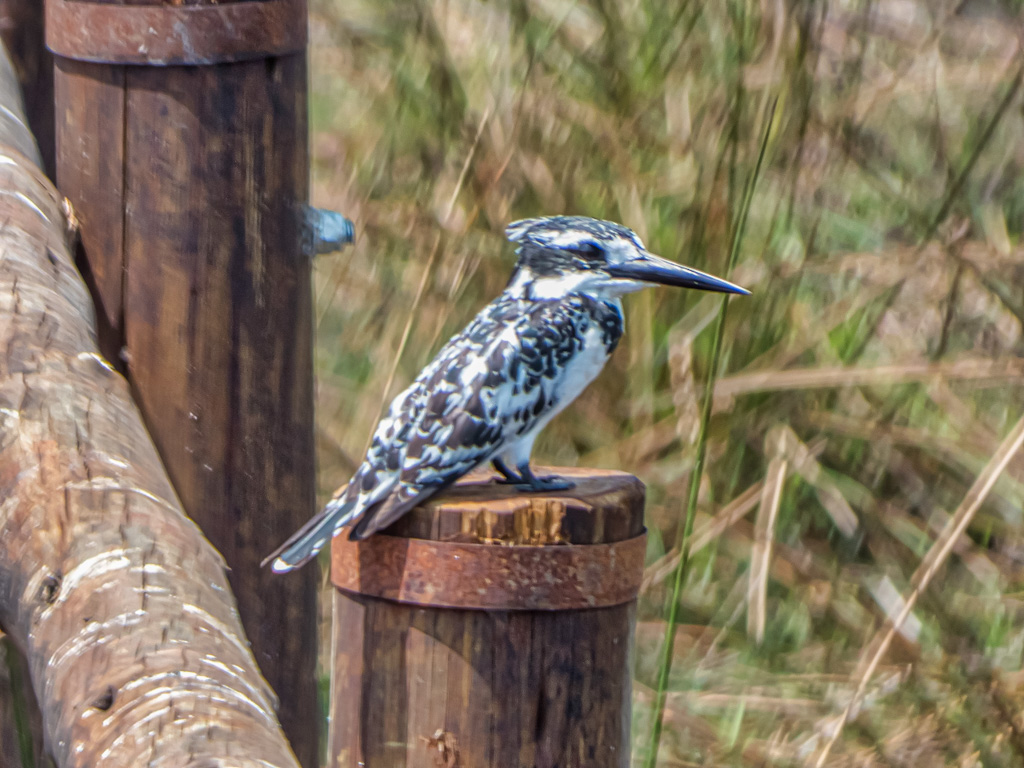
The Pied Kingfisher (Ceryle rudis) is a water kingfisher and is found widely distributed across Africa and Asia. It attains a length of 9-9.8 in (23–25 cm) and a weight of 2.5-3.9 oz (70–110 g). Originally described by Linnaeus in 1758, it has five recognized subspecies. Its black and white plumage, crest and the habit of hovering over clear lakes and rivers before diving for fish make it distinctive. Males have a double band across the breast while females have a single gorget that is often broken in the middle. They are usually found in pairs or small family parties. When perched, they often bob their head and flick up their tail. Male has double breast band; female has a single, incomplete breast band. The pied kingfisher is estimated to be one of the three most numerous kingfishers in the world; the other two are the common kingfisher and collared kingfisher. It a noisy bird, hard to miss.
Crested Barbet
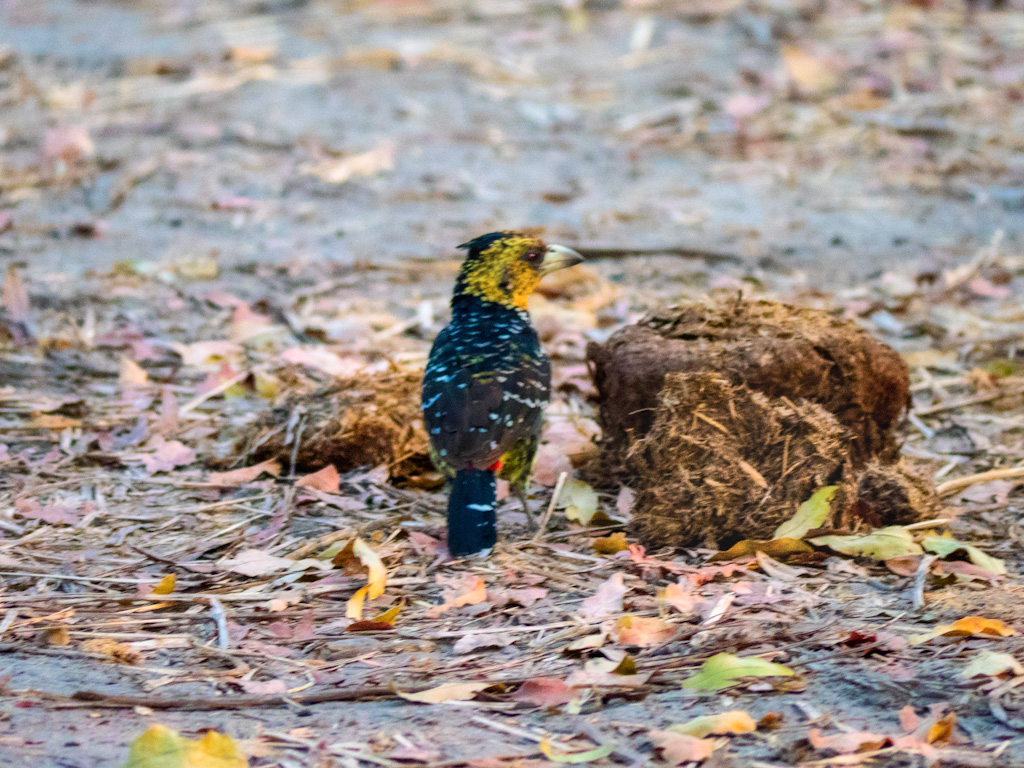
The Crested Barbet (Trachyphonus vaillantii) is a sub-Saharan bird in the Lybiidae family. Its specific name commemorates François Levaillant, a famed French naturalist. With its thick bill and very colorful plumage the crested barbet is unmistakable. This small bird has a speckled yellow and red face with a small black crest. The belly is yellow with red speckles, wings are black with white specks and it has a broad black band on its neck. Yellow head and body with black and white feathers, red markings on the ends of it’s body, its color blends well in the bush. They like to bounce around on the ground looking for food, they usually call from a branch out in the open. The crested barbet feeds on insects, other birds’ eggs and fruits and sometimes mice. They do not fly easily and then only for short distances. Crested barbets roost in holes in trees. They are very vocal, the call being a trill that can continue for long periods.
Cuckoos and Coucals
The cuckoos are a family of birds, Cuculidae, the sole taxon in the order Cuculiformes. The cuckoo family includes the common or European cuckoo, roadrunners, koels, malkohas, couas, coucals and anis.
Burchell’s Coucal
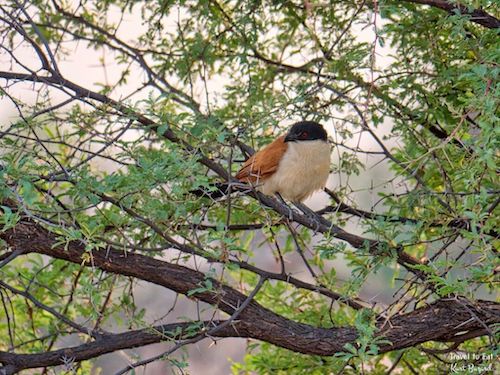
Burchell’s Coucal (Centropus burchellii), is a species of cuckoo in the Cuculidae family, reaching a length of 16 in (41 cm) with a weight of 5.6-7.4 oz (160–210 g). It is found in sub-Saharan Africa. It inhabits areas with thick cover created by rank undergrowth and scrub, including suitable coastal regions. It is sometimes considered a subspecies of the white-browed coucal. The Burchell’s coucal is predatory, stalking through thick bush and eating insects, snails, amphibians (frogs and toads), reptiles (including lizards and chameleons) and birds up to the size of a laughing dove.
White-Browed Coucal
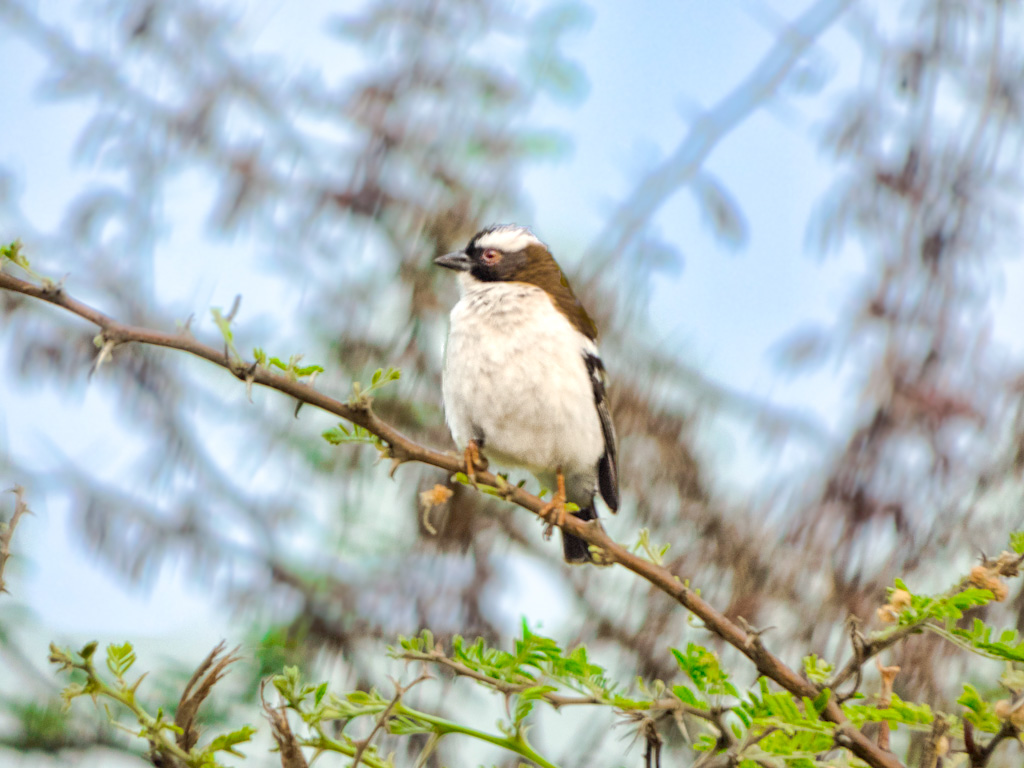
The White-Browed Coucal (Centropus superciliosus), is a species of cuckoo in the Cuculidae family, reaching a length of 15.7 in (40 cm) with a weight of 5.1-7.4 oz (145–210 g). It is found in sub-Saharan Africa and is fairly common in Zimbabwe, Botswana and Mozambique, living in thick vegetation. It feeds on a wide a wide variety of animals, such as mammals, birds and insects. It inhabits areas with thick cover created by rank undergrowth and scrub, including in suitable coastal regions. Burchell’s coucal is sometimes considered a subspecies. According to popular Southern African lore, this species’ distinctive call, which resembles water pouring from a bottle, is said to signal impending rainfall, earning the bird the name “Rainbird.”
Boubous and Shrikes
Laniarius is a genus of brightly coloured, carnivorous passerine birds commonly known as boubous or gonoleks. Not to be confused with the similar-sounding genus Lanius, they were formerly classed with the true shrikes in the family Laniidae, but they and related genera are now considered sufficiently distinctive to be separated from that group as the bush-shrike family Malaconotidae.
Crimson-Brested Shrike
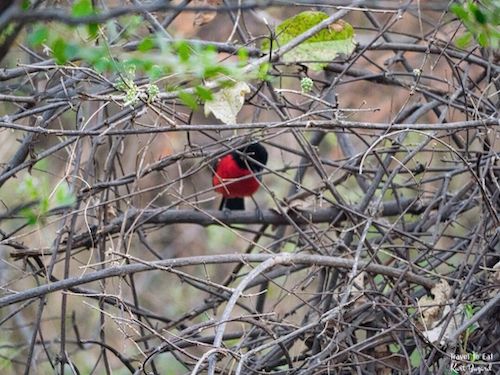
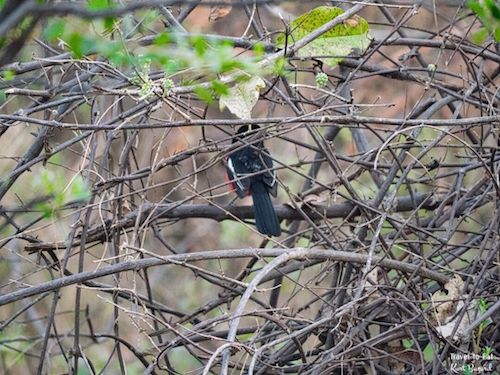
The Crimson-Breasted Shrike (Laniarius atrococcineus) or the crimson-breasted gonolek, (‘gonolek’ – supposedly imitative of its call), is a southern African bird. It has black upper parts with a white flash on the wing, and bright scarlet underparts. The species was first collected by William John Burchell in 1811 near the confluence of the Vaal and Orange Rivers. He named it atrococcineus meaning ‘black/red’, finding the striking colour combination quite remarkable. The generic name Laniarius was coined by the French ornithologist Louis Jean Pierre Vieillot and was meant to call attention to the butcher-like habits of the group. In South West Africa its colours reminded Germans of their homeland flag and it therefore became the Reichsvogel (“Empire bird”). The sexes have the same coloration and are indistinguishable from each other. The upper parts, including the wings and tail, are black, the wings having a broad white bar. The underparts are vivid scarlet.
Magpie Shrike
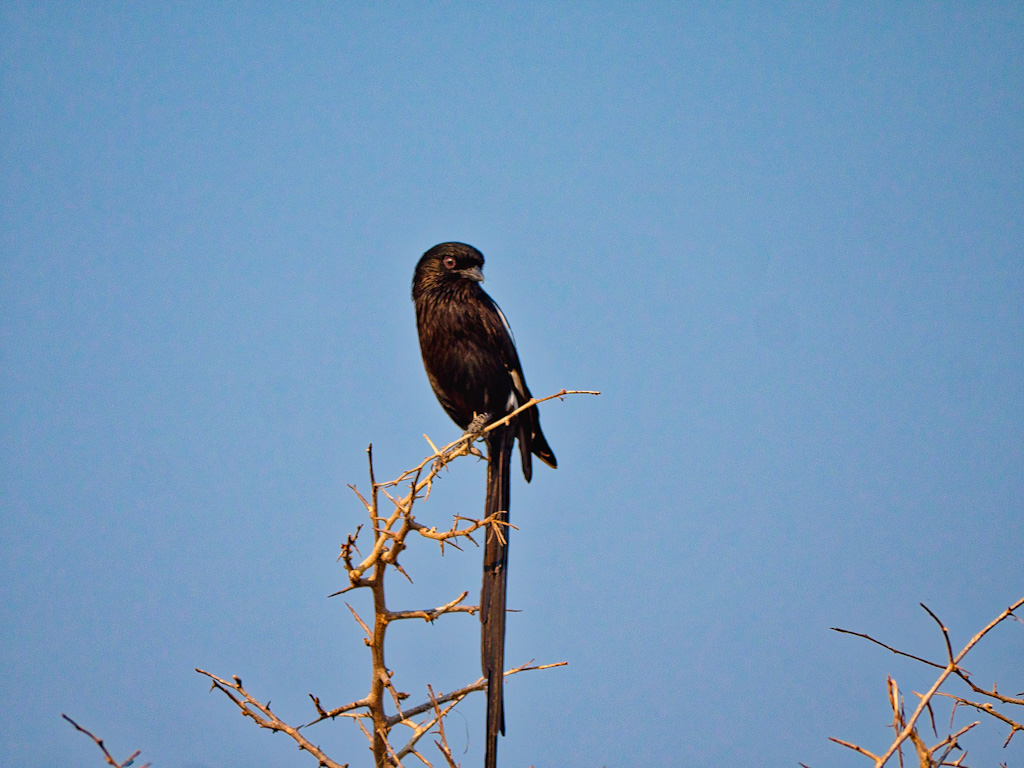
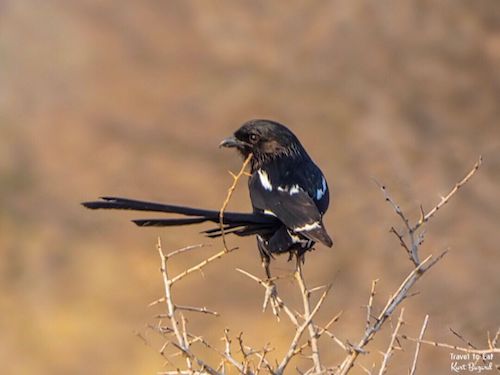
The Magpie Shrike (Urolestes melanoleucus), also known as the African long-tailed shrike, is a species of bird in the Laniidae family. It has a very long tail and is about 1.5 ft (40–50 cm) long including the tail. The adults are black while the juveniles are sooty brown as seen above. It is native to the grasslands of eastern and southeastern Africa, where its natural habitats are dry savannah, moist savannah, and subtropical or tropical dry shrubland. It may associate with other birds such as the white-headed buffalo weaver (Dinemellia dinemelli). The birds nest cooperatively during the rainy season, and their breeding territory is about 7 acres (3 hectares) and defended from other groups. This bird perches in an elevated position scanning the ground below for possible prey. Most prey is caught on the ground, but flying insects are sometimes caught in mid air. The diet consists of arthropods, insects, lizards, small mammals and fruit.
Northern Fiscal
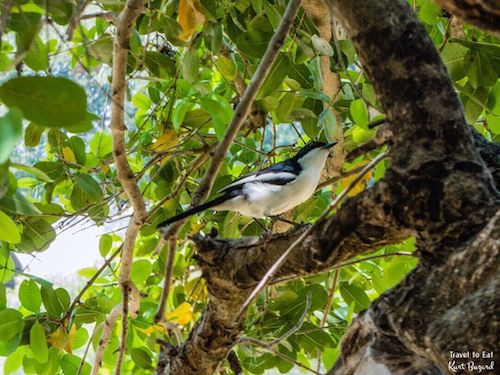
The Northern Fiscal (Lanius humeralis) is a member of the shrike family found through most of Sub-Saharan Africa. It used to be grouped with the southern fiscal (Lanius collaris). Together they were called the common fiscal. This is a fairly distinctive 8–9 inches (21–23 cm) long bird with white underparts and black upperparts extending from the top of the head down to the tail. The bird has a characteristic white ‘V’ on the back and a relatively long black tail with white outer feathers and white tips on the other feathers. The bill, eyes and legs are black. Compared to the rest of the shrikes, the Northern Fiscal is quite unusual in that a pair will hold a territory throughout the year. Its main hunting method is sit-and-wait foraging and about three-quarters of its day is spent on the lookout for prey. It also hovers before pouncing and chases and flushes prey out of undergrowth.
Burchell’s Starling
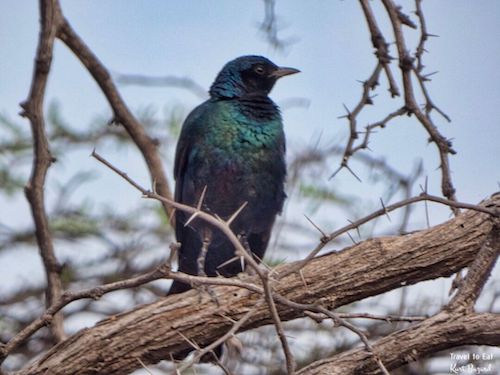
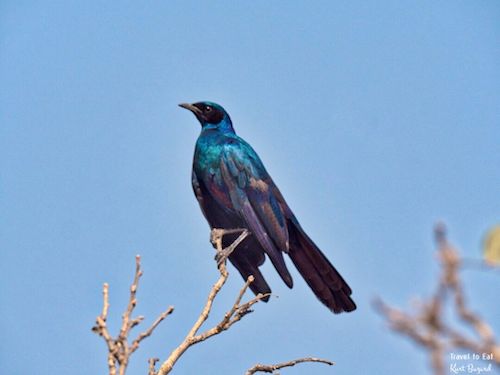
Burchell’s Starling or Burchell’s Glossy-Starling (Lamprotornis australis) is a species of starling in the family Sturnidae. The name of this bird commemorates the English naturalist William John Burchell. Burchell’s starling or Burchell’s glossy-starling (Lamprotornis australis) is a species of starling in the family Sturnidae. It is found in Angola, Botswana, Mozambique, Namibia, South Africa, Swaziland, Zambia, and Zimbabwe. In some light it looks black but with the right lighting the blue coloration emerges. When you see this starling briefly or at the wrong angle, it looks black, rather than the kaleidoscope of colors seen above.
Fork-Tailed Drongo
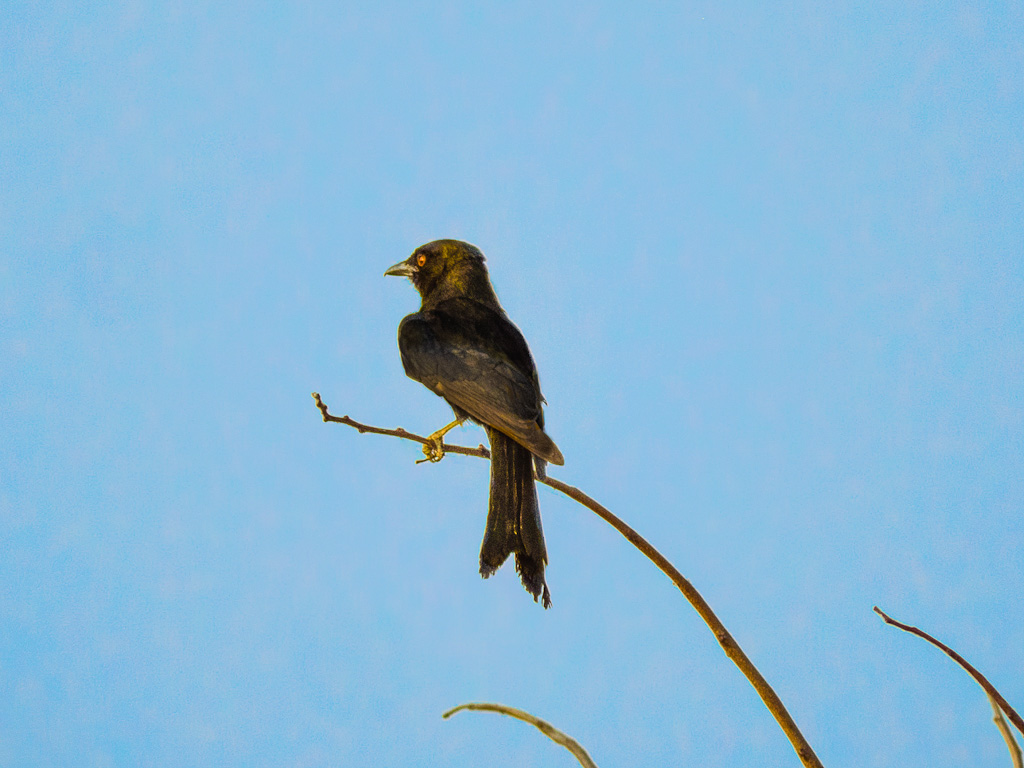
The fork-tailed drongo, also called the common drongo, African drongo, or savanna drongo (Dicrurus adsimilis), is a species of drongo in the family Dicruridae, which are medium-sized birds of the Old World. They are native to the tropics, subtropics and temperate zones of the Afrotropics. Its range was formerly considered to include Asia, but the Asian species is now called the black drongo (Dicrurus macrocercus). They are almost exclusively carnivorous, but may take nectar when available. They flycatch or take prey from the ground, and are attracted to bush fires. Drongos sometimes act as sentries when a predator is approaching, warning their neighbours with genuine alarm calls. But drongos also earn a quarter of their daily calories by sounding a false alarm when another animal finds food. When the meerkats and babblers flee from the non-existent predator, the drongo steals their food.
Red Billed Oxpecker
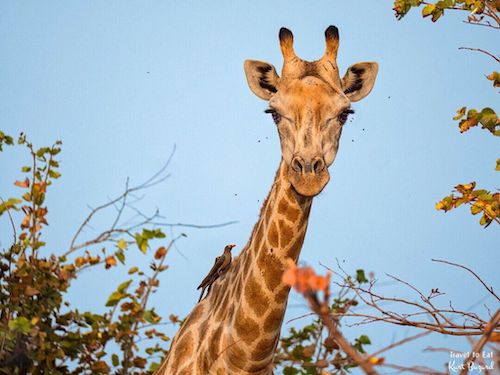
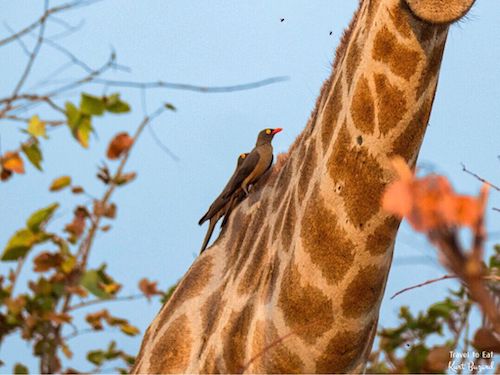
The Red-Billed Oxpecker (Buphagus erythrorhynchus) is a bird in the starling and myna family, Sturnidae; some ornithologists regard the oxpeckers to be in a family by themselves, the Buphagidae. It is about 7.5 in (19 cm) long. It is native to the savannah of sub-Saharan Africa, from the Central African Republic east to South Sudan and south to northern and eastern South Africa. Its range overlaps that of the less widespread yellow-billed oxpecker. The preferred habitat is open country, and the red-billed oxpecker eats insects. Both the English and scientific names arise from this species’ habit of perching on large wild and domesticated mammals such as cattle and eating ticks. An adult will take nearly 100 blood-engorged female Rhipicephalus (Boophilus) decoloratus ticks, or more than 12,000 larvae in a day. However, their preferred food is blood, and while they may take ticks bloated with blood, they also feed on it directly, pecking at the mammal’s wounds to keep them open.
Bennet’s Woodpecker
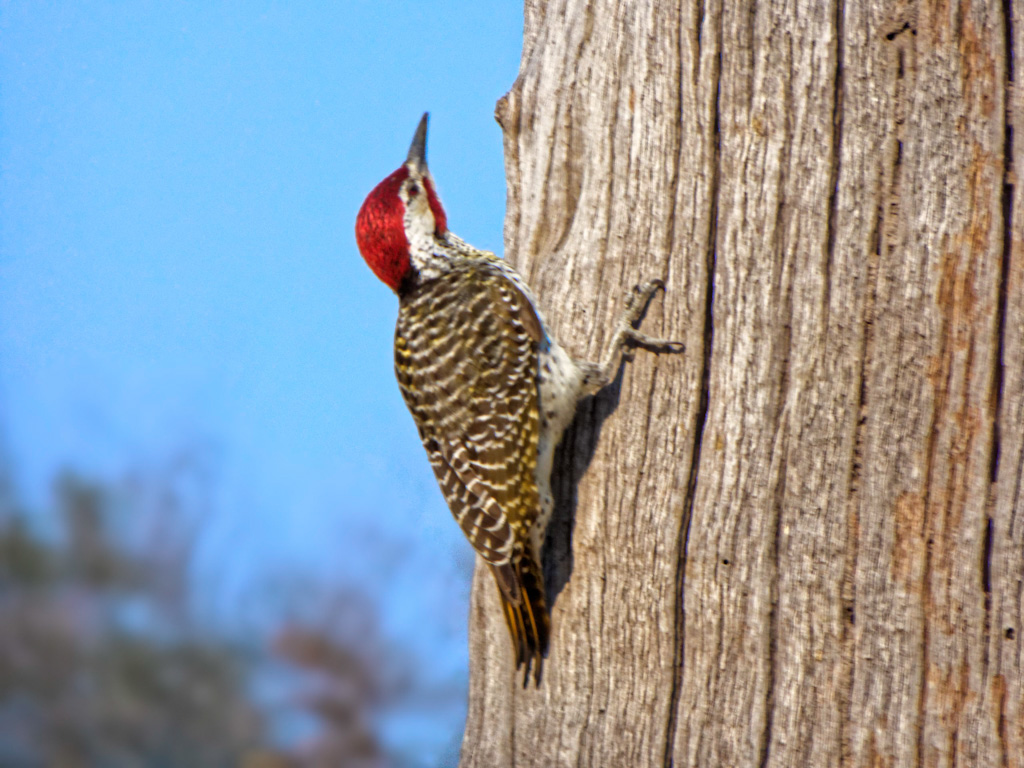
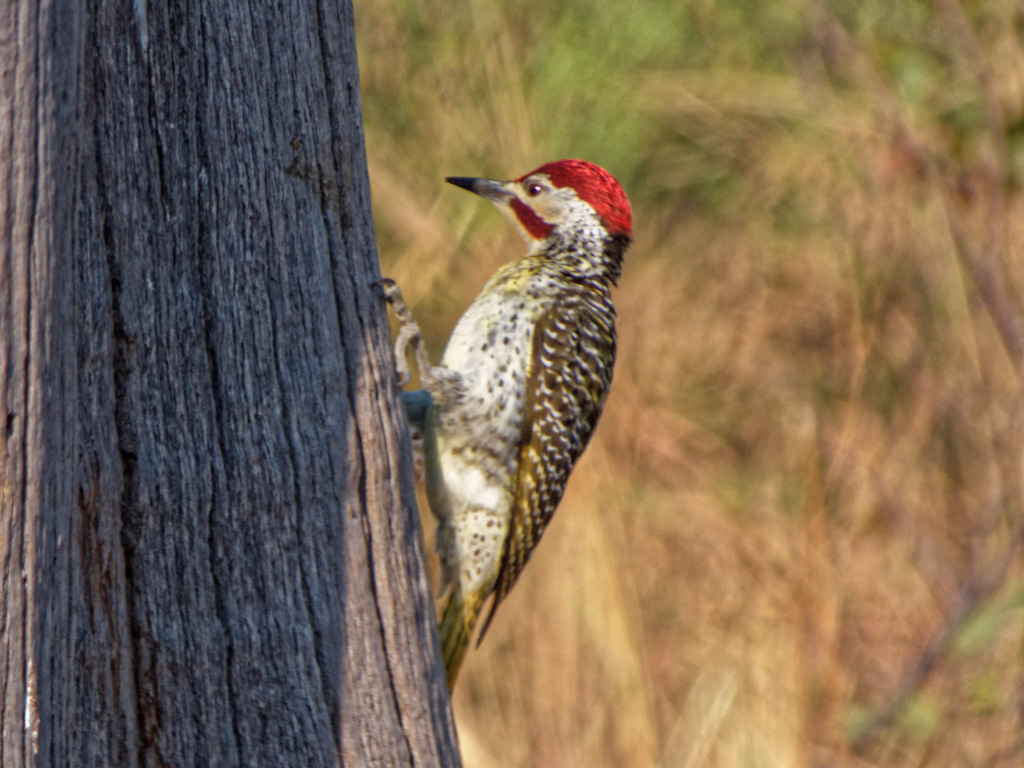
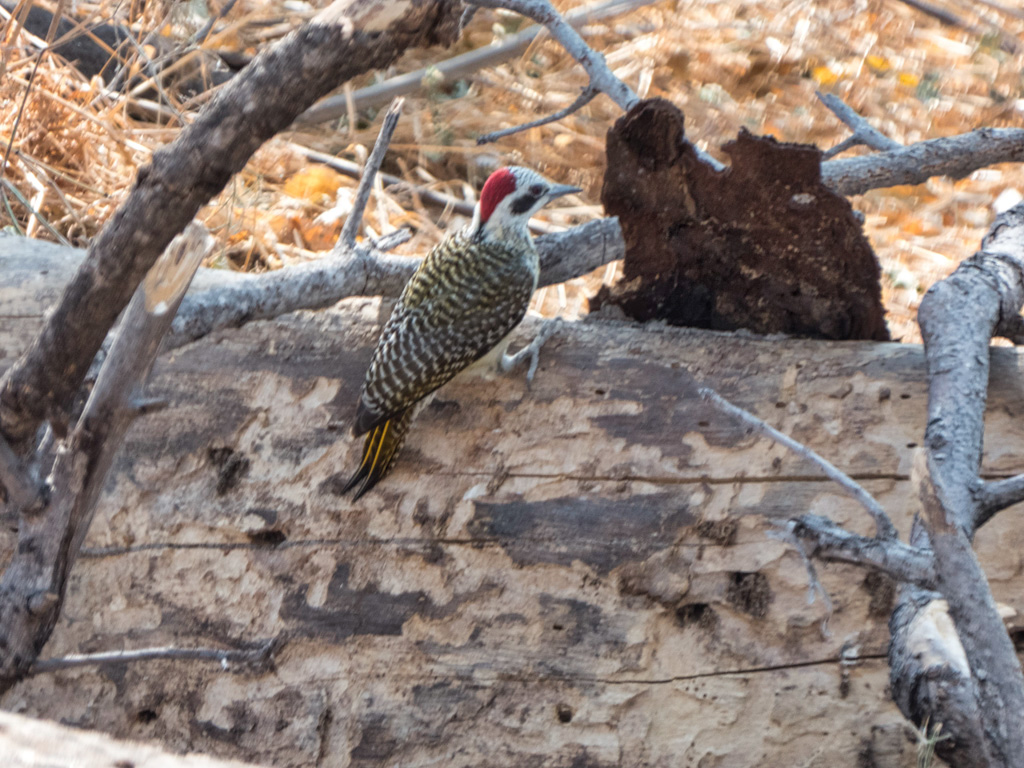
The Bennett’s woodpecker (Campethera bennettii) is a species of bird in the family Picidae. It is found in woodlands and bushes in Africa. The International Union for Conservation of Nature (IUCN) has assessed it as a least-concern species. Its habitat is woodlands and bushes, including miombo, Baikiaea, Acacia and mopane woodlands. It mostly forages on the ground, either bare or with short grass, and also feeds in trees. It mostly eats ants and termites, including their eggs. This species was described by Andrew Smith in 1836. Two subspecies are recognised: Campethera bennettii bennettii and C. b. capricorni. Best told from male Golden-tailed Woodpecker by white throat and spotted (not streaked) breast. Female has diagnostic brown throat and cheek stripe; forecrown blackish with white spots. Sides of neck, breast and flanks are spotted in C. bennetti , but C. b. capricorni (n Namibia and nw Botswana) has little spotting, and is paler, with a yellow wash on underparts and rump.
Black Winged Pratincole
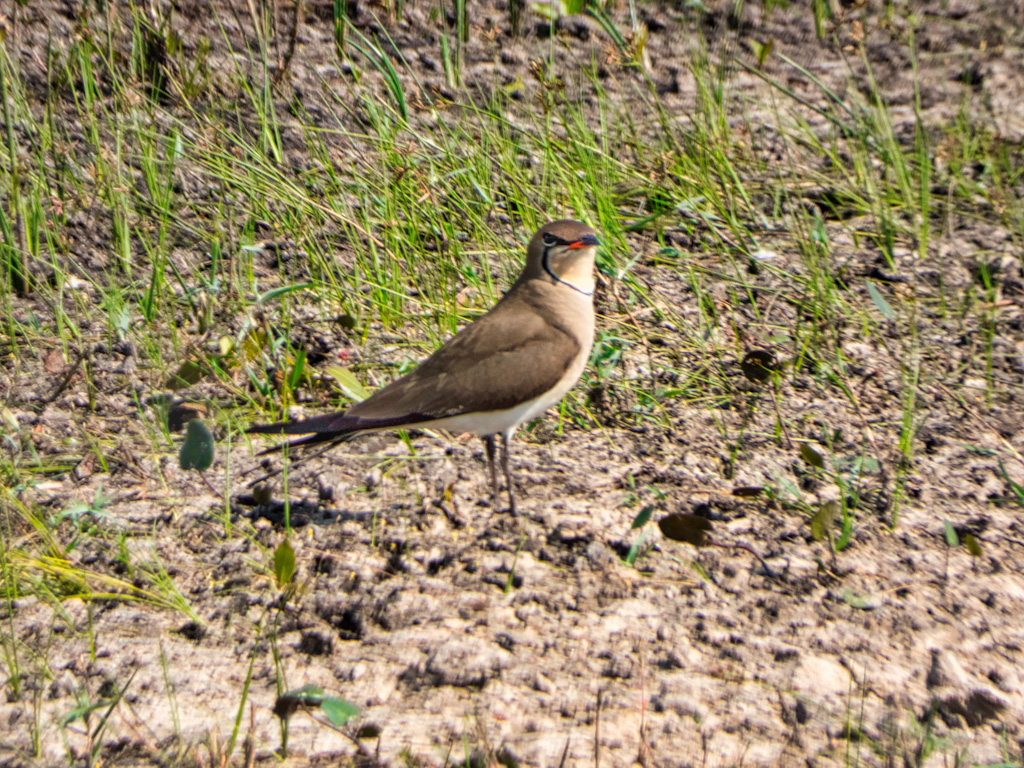
The Black-Winged Pratincole (Glareola nordmanni) is a wader in the pratincole bird family, Glareolidae. The genus name is a diminutive of Latin glarea, “gravel”, referring to a typical nesting habitat for pratincoles. The species name commemorates the Finnish-born zoologist and explorer Alexander von Nordmann. The black-winged pratincole is a bird of open country and is often seen near water in the evening, hawking for insects. This pratincole is found in warmer parts of south east Europe and south west Asia. Its 2–4 eggs are laid on the ground. It is migratory, wintering in tropical Africa, and is rare north or west of the breeding range. Southern Africa (Botswana) supports most of the world population during the southern summer. Numbers and flock sizes decreased dramatically during the 20th century, but occasional large flocks still occur. Very good views are needed to distinguish this species from other pratincoles, such as the collared pratincole and the oriental pratincole which may occur in its range.
Speckled Mousebird
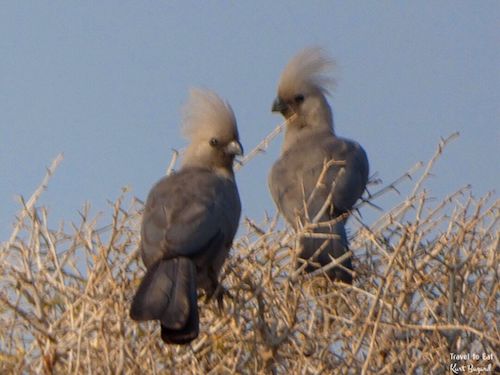
The Speckled Mousebird (Colius striatus) is the largest species of mousebird, as well as one of the most common. It is distributed from Cameroon east to Eritrea and Ethiopia, south through eastern Africa to southern South Africa. Most habitats are suitable for this species, except the rainforests and more arid areas. This mousebird prefers open bushveld habitats. It is widespread in savanna and open woodlands, as well as areas with tangled thickets. It is a common “backyard bird,” often seen in urban areas that contain gardens and orchards.
Spurfowl or Francolins
The Phasianidae are a family of heavy, groundliving birds which includes pheasants, partridges, junglefowl, chickens, Old World quail, and peafowl. The family includes many of the most popular gamebirds. Pternistis is a genus known commonly as francolins or spurfowl but are closely related to jungle bush quail, Alectoris rock partridges and Coturnix quail.
Red Billed Spurfowl
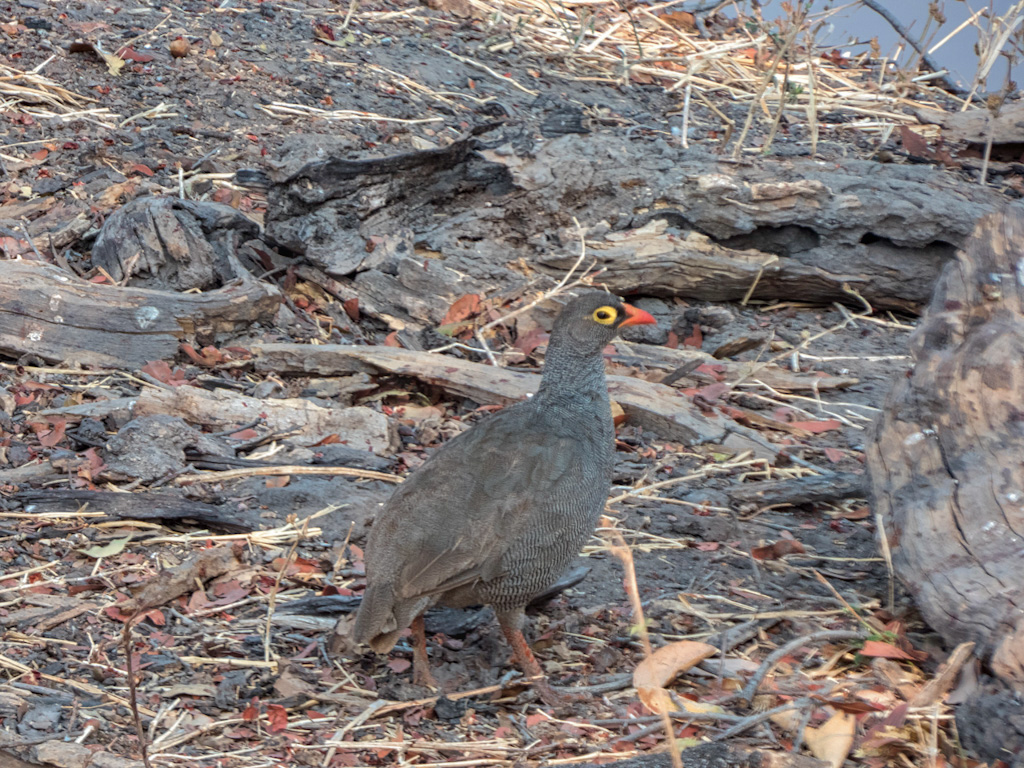
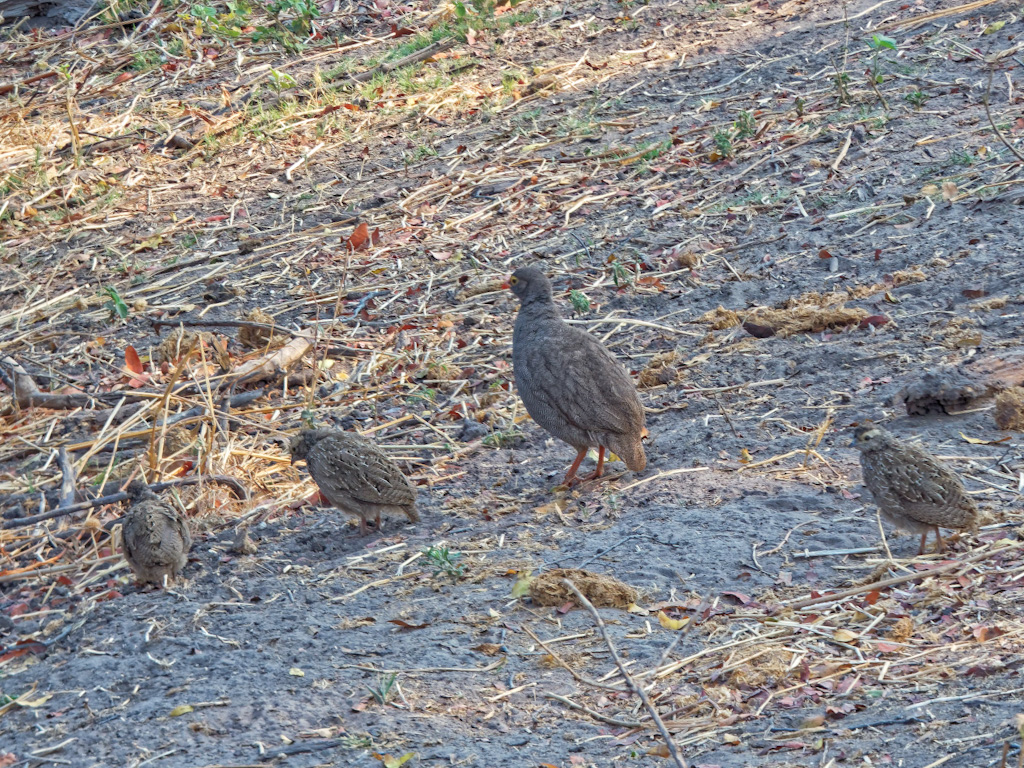
The Red Billed Spurfowl (Pternistis adspersus), also known as the red-billed francolin, is a species of bird in the family Phasianidae. It attains a length of 14-15 in (35–38 cm) and can weigh 12.3-22 lb (350–620 g), males are larger than females. It is found in Southern Africa, including Angola, Botswana, Namibia, South Africa, Zambia, and Zimbabwe. It is the only francolin in southern Africa with yellow around the eye. This, as well as the combination of red bill, red legs, absence of white or red on the throat make identification of this species easy. Plumage of the male and female is similar but the male can be distinguished by his long, sharp leg spurs.
Swainson’s Spurfowl
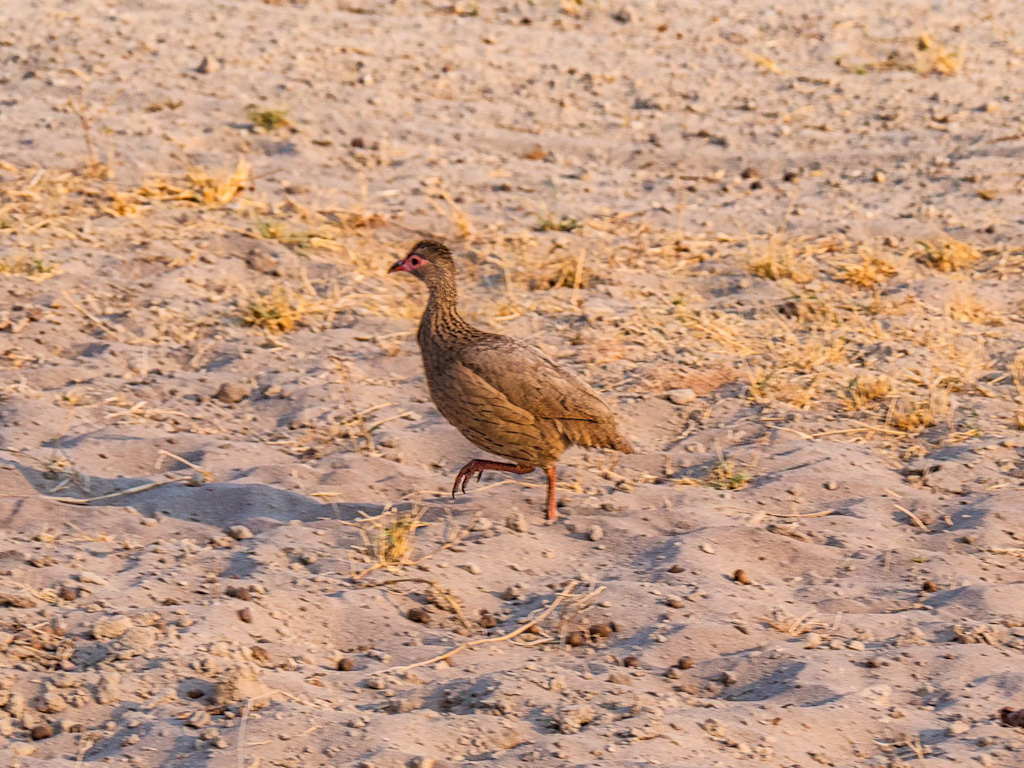
Swainson’s Spurfowl, Swainson’s francolin or chikwari (Pternistis swainsonii) is a species of bird in the family Phasianidae. It attains a length of 13-15 in (33–38 cm) and can weigh 12.3-29 lb (350–820 g), males are larger than females. It is found in Angola, Botswana, Lesotho, Malawi, Mozambique, Namibia, South Africa, Swaziland, Zambia, and Zimbabwe. In the Shona language in Zimbabwe this bird is called the chikwari and is considered a delicacy by outdoor and hunting enthusiasts. Swainson’s francolin was named after William Swainson, an English ornithologist.
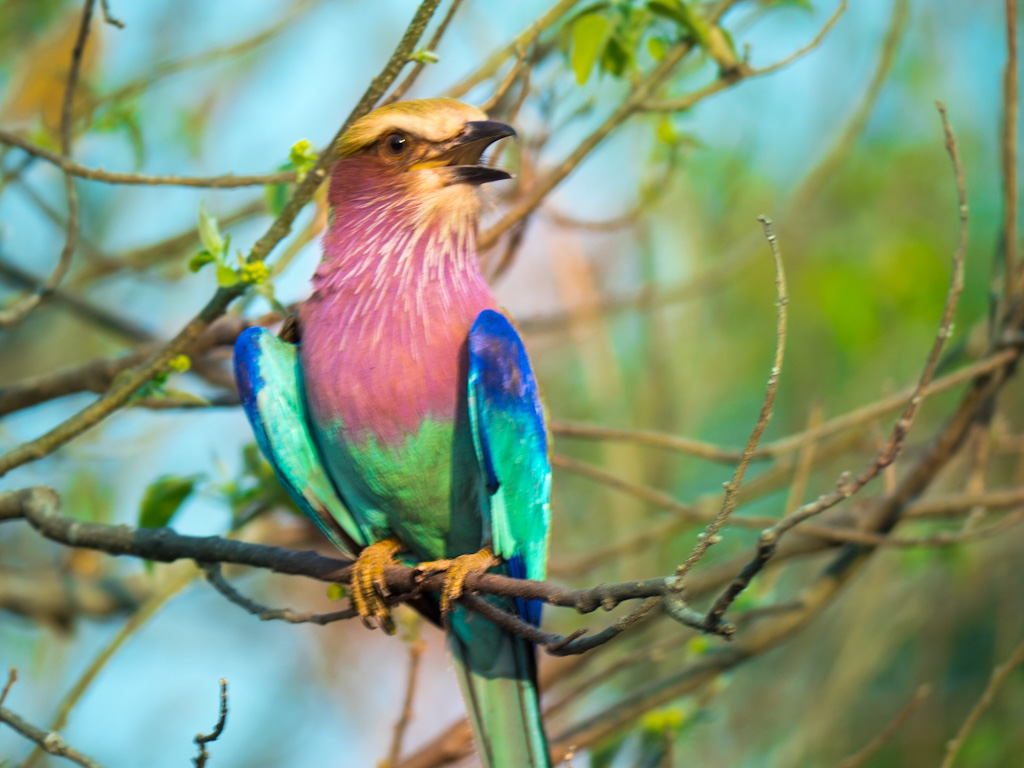
I hope you enjoyed the post, please leave a comment.
References:
https://isafari.nathab.com/wildlife/birds
[http://www.world-birds.com/birds/a/botswana](http://www.world-birds.com/birds/a/
http://help.ebird.org/customer/portal/articles/1848031-ebird-mobile-apps-overview

